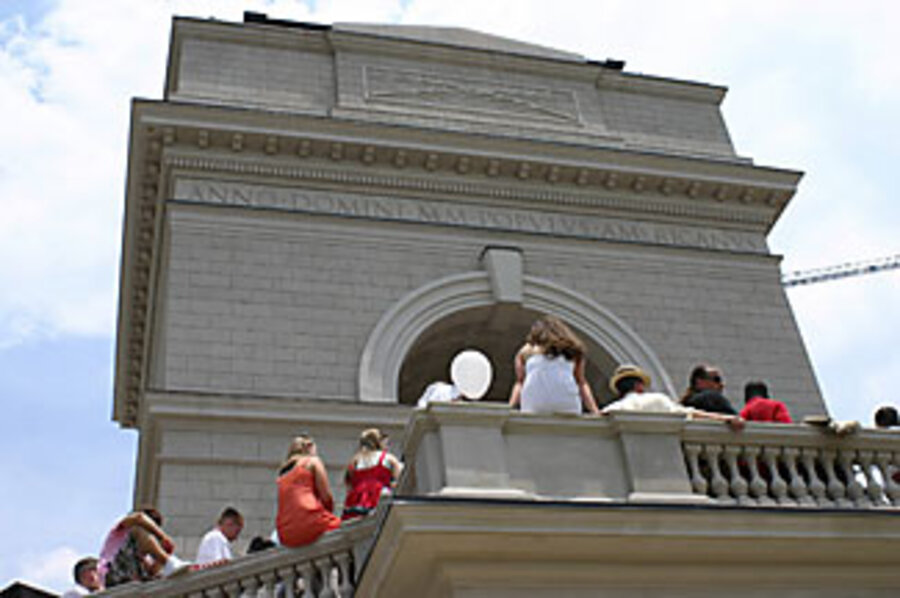'Arc d'Atlanta' ... or a new bit of kitsch?
With a 21-gun salute, a $20 million, 82-foot-tall Roman arch became Georgia's biggest roadside monument this weekend, supplanting Marietta's 77-foot-tall "Big Chicken."
The first classical monument built in the US since the Jefferson Memorial in 1936, the so-called Millennium Gate, dedicated to peace and justice, came a few years late and a bit scaled down, not to its intended resting place in Washington, D.C., but to the capital of the Southeast. Its architectural neighbors include an old steel mill smokestack, an Ikea box store, and cranes erecting modern lofts with art deco facades.
A design inspired by the Arch of Titus in Rome, the Atlanta arch is a giant double-take, a serious statement that risks, against the topsy-turvy backdrop of modern mass development, to become a legacy to 21st-century kitsch.
But for its creator, an urban revivalist named Rodney Cook Jr., the arch isn't just a nod to the influence of Rome, Egypt, and Greece on a modern democracy, but also a bold way marker for a sprawling Southern juggernaut in search of an international identity. It represents, too, an arduous journey for a band of classicists determined to bring not just classical thought, but architecture, back into the public square.
"What we were trying to do with the Millennium Gate is emulate the best of Western architecture," says Mr. Cook, a scion of one of Atlanta's oldest families and a controversial figure in the South's architectural circles. "It's not an ego trip."
As a child, Cook made paper sculptures inspired by the Arch of Titus, which Napoleon also used as the inspiration for the Arc de Triomphe. As a student in Rome, Cook came up with the idea of the Millennium Gate as a way for America to mark "the height of its power" at the turn of the millennium.
With lots of support in Washington, it may have come off as a $50 million version at Barney Square in Washington. "But then the plane hit the Pentagon," Cook says, and a monument to peace was on the outs in Congress.
Enter not just Atlanta's own classical roots – not just of the Confederacy's colonnades, but architectural ideals embodied by the late Atlanta architect Philip Schutze, whose thumbprints are all over the Phoenix City. A massive "new urbanist" development called Atlantic Station was looking for a centerpiece, and with lots of deliberation, the National Monuments Foundation, founded and led by Cook, agreed to revamp the plans and build it in Atlanta.
The gate is built entirely with private funds, and Cook considers it his gift to a city with which he has sparred before over architectural direction and monuments. The idea of a triumphal arch set into a neighborhood that didn't exist five years ago is an example of American willpower at a time when Americans are searching for meaning, says Bob Barr, the former congressman and current Libertarian Party presidential candidate.
"Just as Atlanta is the city too busy to hate, we have to always work to ensure Atlanta is not a city too busy to remember or too busy to honor or a city too busy to build," says Mr. Barr.
Critics have already panned it as Arc D'Ikea. Residents bombarded the online architecture forum Skyscraperpage.com with arch invective, one writer calling it "a kitschy McMonument that bespeaks a cultural inferiority complex."
"It appears to be another attempt to make Atlanta look like other cities," says Kristen Eberhart, who lives near the monument. "It's neat, but I wish Atlanta would start concentrating on its own personality."
For Cook, architectural dissonance at Atlantic Station doesn't detract from the monument's power. The structure, he says, is likely to be standing through more urban changes, even tear-downs, on this corner near Atlanta's midtown, a few hundred yards from the rumbling 16 lanes of the city's downtown connector.
"In any modern city, you have these things smash into each other all the time," he says. "We need to build things that ennoble our people and give them great civic spaces to enjoy each other. Classicism is the architecture of democracy."
Hugh Petter, the project's London-based architect, says the arch represents professional as well as creative freedom. Since World War II, large-scale classical monuments and buildings have been all but impossible to build in Europe. The arch is a testament to teamwork and one man's dream of Roman ideals, he says, even though others might point out that the country itself hasn't seemed too interested in monumentalizing its modern achievements, at least not in classical terms.
But traditions are changing, and the Millennium Gate may be part of that.
"Modernism when it started was a revolution that was very attractive to younger, creative individuals, but it's grown so distorted and out of control," says New York sculptor George Kelly, who created a massive bust of George Washington for the gate's 12,000-square-foot museum. "People are more drawn to tradition. It's the scale of it, it's the warmth of it. The word is beauty."





